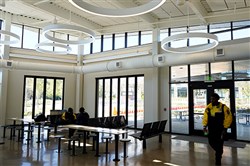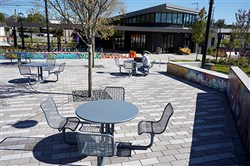VOL. 48 | NO. 43 | Friday, October 25, 2024
More than more buses
By Kathy Carlson
It’s déjà vu all over again. For the second time in six years, Nashville voters get to decide on how to pay for a slate of local transportation programs that, backers say, would give people more ways to get around town and set up a system and regular funding for continuing to develop the system.
Again, Nashvillians are being asked to pay higher sales taxes to help pay for the program, which also borrows money through municipal bonds and would tap federal and state grants.
This plan would increase the local-option part of the sales tax by a half cent, raising Nashville’s total sales tax on nonfood purchases to 9.75%, the same as in most surrounding counties. The sales tax hike would generate about $150 million a year dedicated to transportation projects, a revenue stream the city has never had.
For the second time in six years, residents agree that traffic is a headache but disagree on how to deal with it. And they’re being told again the time for action is now.

The plan would include more bus transit centers around Metro with direct routes between them.
-- Photo By Michelle Morrow |The LedgerMayor Freddie O’Connell’s administration outlines the plan in a 100-plus-page document called the Transportation Improvement Program, or TIP. Construction cost in 2024 dollars is about $3.1 billion, with total spending of $6.934 billion in future dollars during the 15 years in which TIP programs will be built.
The $6.934 billion comes from the sales tax, issuance of $2 billion in 30-year revenue bonds and $1.52 billion from federal and state grants, with the remainder from farebox revenues. Bonds would be issued between 2026 and 2039.
The administration’s strategy to sell the TIP seems low key, with a mayor’s office representative telling people at community meetings they would outline the plan, not advocate for or against. But attendees and others did.
“If you never want to get on a bus, this plan will help you,” Vice Mayor Angie Henderson told about 75 people at a community meeting in District 23’s Brook Hollow Baptist Church Oct. 6. She highlighted the new sidewalks, better timing of traffic lights and safety enhancements the TIP proposes for high-accident corridors, saying they will improve transportation for pedestrians and drivers as well as bus riders.
“Your local government doing basic things better and at a bigger scale may be boring, but I can tell you with confidence it is the right thing to do,” Henderson wrote in a recent opinion piece for the Tennessean. Henderson, who served on Metro Council for two terms before being elected vice mayor last year, opposed the 2018 plan. It was defeated in a referendum that year.
Former Metro Council member Emily Evans, who served two terms ending in 2015, opposes the plan because it is based on increasing an already regressive sales tax, which takes a greater percentage of lower income residents’ incomes. Nashvillians already have absorbed a 34% hike in property taxes in 2020, she says, and don’t need more taxes, and the city itself has had “very little population growth since 2016.”
Evans also says TIP offers an outdated transportation plan centered on bus mass transit, citing surveys showing declining ridership for the past 50 years. Moreover, she says, the plan offers a limited, negative vision of the future in which it’s considered a plus for families to take transit and have only one car rather than the two cars that many see as signs of prosperity.
Focused on the basics
The TIP focuses on four S’s:
• Signaling: Replacing 592 of Davidson County’s traffic lights with smart signals to help drivers avoid stop-and-go driving
• Service: Making WeGo transit service available 24 hours a day, accommodating people who work outside daytime working hours and those attending entertainment and sporting events
• Sidewalks: Adding or upgrading 86 miles of sidewalks over 15 years
• Safety: Improving 78 miles of roads identified as sites of 59% of traffic fatalities and serious injuries
(See sidebar for what the TIP pays for.)
The recently opened Dr. Ernest Rip Patton Jr. Transit Center on Clarksville Pike in North Nashville offers a glimpse of services the TIP could bring. The $17 million facility, built with local, state and federal funding, has six bus bays, including two for WeGo Access for people with mobility issues.
Riders can wait inside or outside, buy tickets and check schedules. And they don’t have to go back downtown to make connections to take certain routes.
The Patton Transit Center is in District 21, represented by second-term Metro Council member Brandon Taylor. Most people are “pretty excited about it,” he says. It’s something that was needed, he adds, and it lets people travel across town without having to go downtown and out of their way to transfer to another bus. He says he wants to see what people say after it has been operating for six months.

Exterior of the Dr. Ernest Rip Patton Jr. Transit Center in North Nashville.
-- Photo By Michelle Morrow | The LedgerTaylor views the TIP mainly as the city’s commitment to building out its transportation infrastructure with sidewalks, better lighting and completed bike lanes. Transit improvements would come along with the dedicated source of transportation funding that the TIP allows.
“We’ve got to build something for the future,” Taylor says. “…Our hands are tied” without a dedicated source of transportation funding. Transportation is a local issue, even though federal and state dollars help pay for transportation services, he says.
The TIP, with its emphasis on basics, stands in contrast to the 2018 plan that would have built a light rail system along five major city streets and placed a tunnel under downtown Nashville to ease traffic congestion. Voters rejected that plan decisively.
More money, more planning
Erin Hafkenschiel was director of the Mayor’s Office of Transportation and Sustainability in 2018 when the transit proposal called Let’s Move Nashville went before voters. She now is president of the nonpartisan think tank Think Tennessee and served this year on O’Connell’s Technical Advisory Committee, which provided input into the TIP.
She says supporting a dedicated source of income for transportation would allow both NDOT and WeGo to do multiyear planning, knowing that money is coming in every year devoted to transportation.
Currently, Nashville pays for transportation services on a piecemeal basis through ongoing spending in annual budgets or longer-term capital spending as determined every year in Nashville’s capital budget, says Alex Apple, O’Connell’s press secretary and deputy communications director.
The approach has left Nashville unable to keep up with transportation needs, Apple says.
“For example, we are hundreds of miles behind on sidewalks,” he continues. “Last year, the city was able to build just 6.5 miles of sidewalk with funding from the Capital Spending Plan.”
Hafkenschiel offers two more reasons supporting a dedicated income source:
• A city can issue bonds paid for through the revenue stream coming from the dedicated funding, supporting long-term investments such as transportation investments.
• It improves Nashville’s chances for being awarded certain federal grants for transportation. Nashville receives some funding for both transit and highways via formula funding, which is not a competitive process but dictated by the city’s population size, she explains.
The big-dollar transit grants are the federal government’s Capital Investment Grants, and Nashville’s application to those funding pots would not be competitive compared to peer cities unless it has dedicated funding, she says.
The TIP would help Nashville catch up to where it needs to be today, Hafkenschiel says. More would be needed in the future for expected growth, particularly expanding to regional counties.
Nashville needs to “get the basics such as traffic signals right before investing in bigger, costlier projects such as light rail,” she says. “The TIP is about building trust in the community with what the city is doing to improve transportation.”
What happens if voters don’t vote in favor of the TIP?
“These needs don’t just disappear because we have had similar conversations on improving much of street infrastructure and transit operations on the same corridors for several decades. Our ability to implement those improvements are very slow,” Apple says of the mayor’s office. “For example, we can build a dozen transit centers with Choose How You Move, and if it doesn’t pass we are likely only able to build one or two transit centers every five years.”
“Metro would continue to fund improvements as best it can through ongoing capital spending and operating budgets,” says WeGo spokesman Eric Melcher. “As happens now, these investments would have to be weighed against other community priorities such as schools, libraries, parks and public safety.”